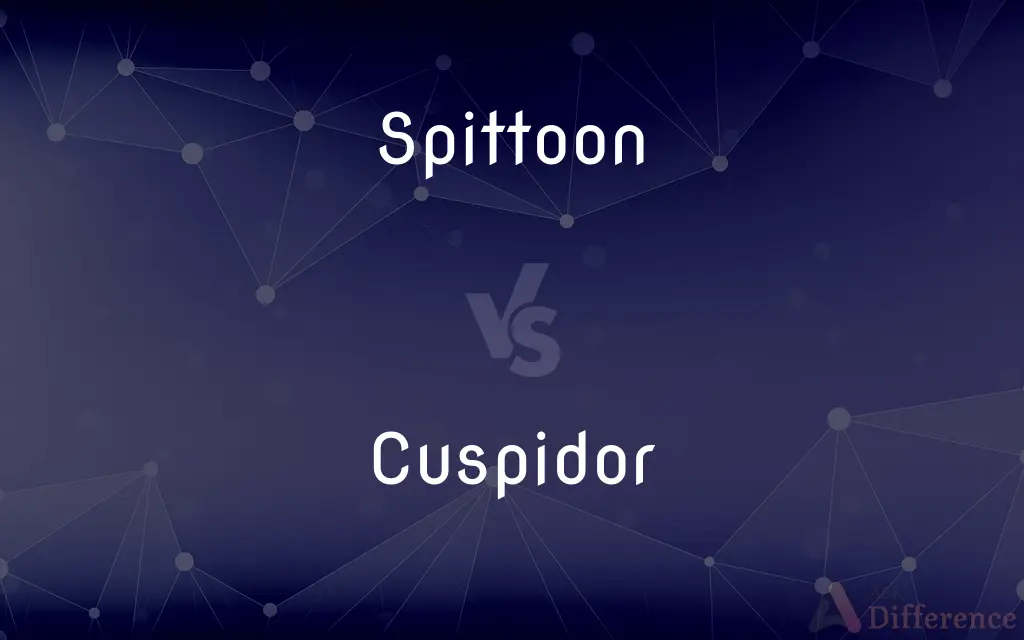Spittoon vs. Cuspidor — What's the Difference?
By Maham Liaqat & Fiza Rafique — Updated on April 4, 2024
Spittoons and cuspidors both serve as receptacles for spit, typically tobacco spit, but the term "cuspidor" is often used for more ornate or public versions.

Difference Between Spittoon and Cuspidor
Table of Contents
ADVERTISEMENT
Key Differences
Spittoons, historically common in places like saloons and barbershops, are designed to contain spit, often from chewing tobacco use. Cuspidors, on the other hand, serve the same purpose but are sometimes associated with more elegant or elaborate designs and can be found in more formal settings or public places.
While spittoons are made from a variety of materials including brass, copper, and even porcelain, cuspidors are particularly noted for their often ornate designs and may also be made from similar materials. This distinction points to the cuspidor’s dual function as both a practical item and a potential decorative piece.
The term "spittoon" is generally used in a more casual context, suggesting its use in everyday, informal settings. Conversely, "cuspidor" is a term that might be used in more formal or official documentation, reflecting its placement in settings like hotels, upscale establishments, or even medical offices.
Maintenance and cleaning of these receptacles are crucial for hygiene. Spittoons, in their traditional settings, required regular cleaning, a task often seen as undesirable. Cuspidors, especially in public or formal settings, might have been subject to stricter hygiene standards and possibly more frequent cleaning routines.
Despite their differences, both spittoons and cuspidors have seen a decline in use and popularity with the decrease in tobacco chewing habits and the increase in public health awareness. They remain, however, interesting historical artifacts that reflect past social habits and preferences.
ADVERTISEMENT
Comparison Chart
Primary Use
Receptacle for spit, especially from chewing tobacco
Same as spittoon, but often with a focus on ornate designs
Material
Brass, copper, porcelain, etc.
Often ornate, made from similar materials
Context
Casual, informal settings
Formal settings, public places
Design
Functional, varying designs
Often more elaborate and decorative
Maintenance
Regular cleaning required
Potentially stricter hygiene standards
Compare with Definitions
Spittoon
Common in saloons, barbershops, and homes in the past.
Every corner of the saloon had a spittoon for patrons' use.
Cuspidor
"Cuspidor" implies a degree of elegance or formality.
The railway station installed cuspidors to discourage spitting on the floor.
Spittoon
Required regular maintenance for hygiene.
Cleaning the spittoon was a daily chore to maintain hygiene.
Cuspidor
An often ornate spit receptacle used in more formal or public settings.
The hotel lobby featured an elegant porcelain cuspidor.
Spittoon
Functional, with some featuring simple decorative elements.
The spittoon featured a simple etched design around its rim.
Cuspidor
Known for elaborate designs, made from high-quality materials.
The ornate cuspidor at the theater entrance was made of polished brass with intricate engravings.
Spittoon
A receptacle for spit, particularly from chewing tobacco, found in casual settings.
The old barbershop had a brass spittoon next to each chair.
Cuspidor
Found in upscale establishments, hotels, and medical offices.
Beside the dentist's chair was a modern cuspidor with automatic flushing.
Spittoon
Made from materials like brass, copper, and porcelain.
The antique spittoon was a heavy copper vessel, tarnished with age.
Cuspidor
Subject to high hygiene standards, often featuring easier cleaning designs.
The public park's cuspidors were cleaned twice a day to ensure sanitation.
Spittoon
A spittoon (or spitoon) is a receptacle made for spitting into, especially by users of chewing and dipping tobacco. It is also known as a cuspidor (which is the Portuguese word for "spitter" or "spittoon", from the verb "cuspir" meaning "to spit"), although that term is also used for a type of spitting sink used in dentistry.
Cuspidor
A spittoon.
Spittoon
A bowl-shaped, usually metal vessel, often with a funnel-shaped cover, into which tobacco chewers periodically spit.
Cuspidor
(chiefly US) A spittoon.
Spittoon
A receptacle for spit.
Cuspidor
Any ornamental vessel used as a spittoon; hence, to avoid the common term, a spittoon of any sort.
Spittoon
A spitbox; a cuspidor.
Cuspidor
A receptacle for spit (usually in a public place)
Spittoon
A receptacle for spit (usually in a public place)
Common Curiosities
What is a spittoon?
A spittoon is a receptacle designed to contain spit, commonly used in conjunction with chewing tobacco.
Where would you typically find a cuspidor?
Cuspidors could be found in more formal settings, such as upscale establishments or public places.
Are spittoons still used today?
The use of spittoons has declined significantly due to decreased tobacco chewing and increased public health awareness.
What is a cuspidor?
A cuspidor is essentially the same as a spittoon but often refers to more ornate versions or those used in formal settings.
How do spittoons and cuspidors differ in design?
Spittoons may have a simple, functional design, while cuspidors are often more elaborate and decorative.
Where would you typically find a spittoon?
Spittoons were commonly found in casual settings like saloons and barbershops.
Can a cuspidor be considered a decorative item?
Yes, due to their often ornate designs, cuspidors can serve as decorative items in addition to their practical use.
How were spittoons and cuspidors maintained?
They required regular cleaning to prevent odors and maintain hygiene, with some designs facilitating easier maintenance.
Why have spittoons and cuspidors fallen out of favor?
The decline is largely due to the decrease in chewing tobacco use and the rise in public health and hygiene awareness.
What materials are spittoons made from?
Spittoons can be made from brass, copper, porcelain, and other materials.
What materials are cuspidors made from?
Cuspidors are made from similar materials as spittoons but may feature more elaborate designs.
Can spittoons be found in museums?
Yes, spittoons and cuspidors are often displayed in museums as historical artifacts.
Do cuspidors have a place in modern design?
While their practical use has declined, cuspidors may still be used as decorative elements in certain design contexts.
Were spittoons used in homes?
Yes, spittoons were also used in homes, particularly in regions where chewing tobacco was common.
Was there a difference in the cleaning of spittoons and cuspidors?
Yes, cuspidors, especially in formal settings, might have been subject to stricter hygiene standards and more frequent cleaning.
Share Your Discovery

Previous Comparison
Cape vs. Headland
Next Comparison
Poignant vs. SadAuthor Spotlight
Written by
Maham LiaqatCo-written by
Fiza RafiqueFiza Rafique is a skilled content writer at AskDifference.com, where she meticulously refines and enhances written pieces. Drawing from her vast editorial expertise, Fiza ensures clarity, accuracy, and precision in every article. Passionate about language, she continually seeks to elevate the quality of content for readers worldwide.














































